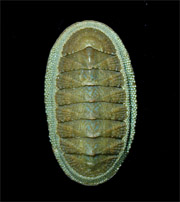Description.
This describes the species using terminology defined in the glossary,
concentrating on features that differentiate this from other species.
Where a range of colour, sculpture or shape exists this is usually
noted.
Size:
Gives the maximum, and if applicable, a typical adult size for the
species, from the collections of the Australian Museum and of the
author, or rarely, from the literature.
Molluscs
grow from microscopic larvae, depositing the shell at the growing or
outer edge. Some species modify the shape of the shell when they
mature, normally by thickening the outer lip, but in the case of the
cowries, by extending the outer lip so that it almost closes the
aperture. In these forms it is possible to tell when the shell has
finished growing, but in species where there is no such modification
of the shell at maturity, it is not possible to tell if the shell has
finished growing or not.
There
is sometimes a wide range in the adult size of specimens within a
species. Within one population most specimens will be around the
average size for the population, with extremely small or extremely
large individuals being rare.. There is often considerable variation
in average size between populations.
For
those families which have been extensively collected by shell
collectors, the size data is skewed because collectors give undue
emphasis to unusually large or small specimens (as well as uncommon
colour forms or sometimes to deformities). This is particularly so
with the much collected Cypraeidae, where the maximum size recorded in
the literature is two or three times the typical size.
Distribution:
The entire distribution is noted, as well as the distribution in
Australia.. Australian distributions are given clockwise around the
Australian coast, so Cape Moreton to south-western WA is a southern
Australian distribution.
The
NSW mollusc fauna is a combination of two distinct faunas - the
Indo-West Pacific and Southern Australian faunas. Northern Australia,
including Queensland and the Great Barrier Reef, is part of the vast
Indo-West Pacific faunal region, which extends from East Africa
through South-East Asia into the central Pacific. Many species which
occur in northern Australia are distributed widely throughout this
zone. It has a high level of species diversity, with many of the
species being large and brightly coloured. The Southern Australian
zone by contract has a different evolutionary origin, with about 95%
of its species endemic. It is far less rich in species, and with
shells having less spectacular colouration.
The
political borders of the state almost exactly mark the limits of
overlap of the two faunas; the northern limit of the southern fauna is
Cape Moreton at the NSW-Queensland border, and the southern limit of
the northern fauna is Cape Howe at the NSW-Victoria border. In the
overlap zone there is a gradual replacement of one fauna with the
other, with the addition of some endemic species. Distribution of
animals of the northern fauna that have long-lived pelagic larvae is
achieved by the East Australian Current, a flow of warm water which
commences in the equatorial region and continues to about Newcastle,
whence it turns seaward. The West Wind Drift which flows along the
southern Australian coast passes through Bass Strait, and sometimes
extends northward up the southern coast of NSW, distributing larvae of
the southern Fauna.
The
same qualifications apply to reported ranges of popularly collected
families as do to size ranges. Over two hundred years of collecting
the range of tropical cowries has been extended well into NSW, but
usually by only a handful of specimens in museum collections. For all
families, apart from the dozen most collected families, our knowledge
of ranges is quite patchy, and is not difficult to extend the reported
range by intensive collecting.
Habitat:
A general statement of habitat is give, such as rocky shore, or
estuarine mud flats. Although we have a good broad understanding of
what lives where from observation and collection, our knowledge of why
animals live there, and the details of their interaction with their
habitat, is generally poor in detail. Distributions sub-tidally are
particularly poorly known.
With
habitat, an estimation of the rarity is given. These ratings have the
following meanings, for an experienced collector collecting living
animals intertidally, or sifting through beach washup.
-
Abundant:
You can't help seeing them when you look in the right place.
-
Common:
A 10 minute search in the right place will find a few
-
Moderately
common: A 10 minute search in the right place will probably
find one
-
Uncommon:
You will probably find one with an hours searching
-
Rare:
You might never find one.
Comparison:
A comparison is given with closely related or similar species.
Synonyms:
Generally, only synonyms from the Australian literature are given.
However, all names are given that appear in A Reference List
of the Marine Mollusca of New South Wales (Iredale &
McMichael, 1962).
